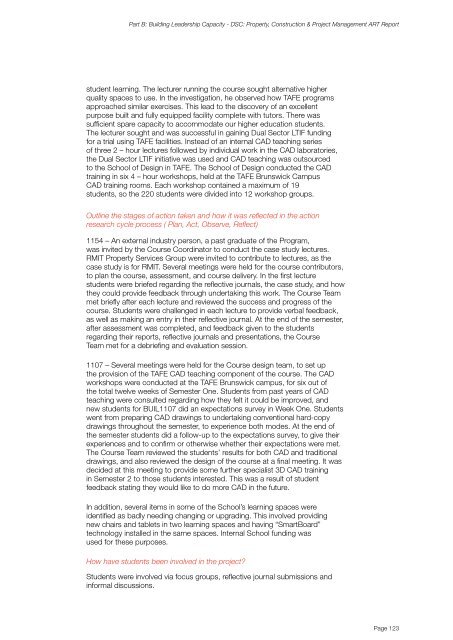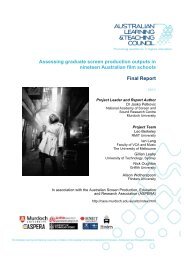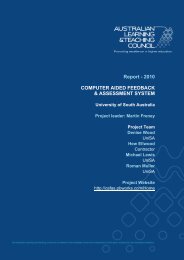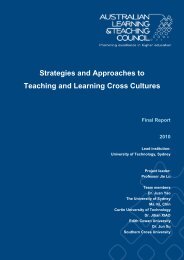student feedback and leadership - Office for Learning and Teaching
student feedback and leadership - Office for Learning and Teaching
student feedback and leadership - Office for Learning and Teaching
Create successful ePaper yourself
Turn your PDF publications into a flip-book with our unique Google optimized e-Paper software.
Part B: Building Leadership Capacity - DSC: Property, Construction & Project Management ART Report<strong>student</strong> learning. The lecturer running the course sought alternative higherquality spaces to use. In the investigation, he observed how TAFE programsapproached similar exercises. This lead to the discovery of an excellentpurpose built <strong>and</strong> fully equipped facility complete with tutors. There wassufficient spare capacity to accommodate our higher education <strong>student</strong>s.The lecturer sought <strong>and</strong> was successful in gaining Dual Sector LTIF funding<strong>for</strong> a trial using TAFE facilities. Instead of an internal CAD teaching seriesof three 2 – hour lectures followed by individual work in the CAD laboratories,the Dual Sector LTIF initiative was used <strong>and</strong> CAD teaching was outsourcedto the School of Design in TAFE. The School of Design conducted the CADtraining in six 4 – hour workshops, held at the TAFE Brunswick CampusCAD training rooms. Each workshop contained a maximum of 19<strong>student</strong>s, so the 220 <strong>student</strong>s were divided into 12 workshop groups.Outline the stages of action taken <strong>and</strong> how it was reflected in the actionresearch cycle process ( Plan, Act, Observe, Reflect)1154 – An external industry person, a past graduate of the Program,was invited by the Course Coordinator to conduct the case study lectures.RMIT Property Services Group were invited to contribute to lectures, as thecase study is <strong>for</strong> RMIT. Several meetings were held <strong>for</strong> the course contributors,to plan the course, assessment, <strong>and</strong> course delivery. In the first lecture<strong>student</strong>s were briefed regarding the reflective journals, the case study, <strong>and</strong> howthey could provide <strong>feedback</strong> through undertaking this work. The Course Teammet briefly after each lecture <strong>and</strong> reviewed the success <strong>and</strong> progress of thecourse. Students were challenged in each lecture to provide verbal <strong>feedback</strong>,as well as making an entry in their reflective journal. At the end of the semester,after assessment was completed, <strong>and</strong> <strong>feedback</strong> given to the <strong>student</strong>sregarding their reports, reflective journals <strong>and</strong> presentations, the CourseTeam met <strong>for</strong> a debriefing <strong>and</strong> evaluation session.1107 – Several meetings were held <strong>for</strong> the Course design team, to set upthe provision of the TAFE CAD teaching component of the course. The CADworkshops were conducted at the TAFE Brunswick campus, <strong>for</strong> six out ofthe total twelve weeks of Semester One. Students from past years of CADteaching were consulted regarding how they felt it could be improved, <strong>and</strong>new <strong>student</strong>s <strong>for</strong> BUIL1107 did an expectations survey in Week One. Studentswent from preparing CAD drawings to undertaking conventional hard-copydrawings throughout the semester, to experience both modes. At the end ofthe semester <strong>student</strong>s did a follow-up to the expectations survey, to give theirexperiences <strong>and</strong> to confirm or otherwise whether their expectations were met.The Course Team reviewed the <strong>student</strong>s’ results <strong>for</strong> both CAD <strong>and</strong> traditionaldrawings, <strong>and</strong> also reviewed the design of the course at a final meeting. It wasdecided at this meeting to provide some further specialist 3D CAD trainingin Semester 2 to those <strong>student</strong>s interested. This was a result of <strong>student</strong><strong>feedback</strong> stating they would like to do more CAD in the future.In addition, several items in some of the School’s learning spaces wereidentified as badly needing changing or upgrading. This involved providingnew chairs <strong>and</strong> tablets in two learning spaces <strong>and</strong> having “SmartBoard”technology installed in the same spaces. Internal School funding wasused <strong>for</strong> these purposes.How have <strong>student</strong>s been involved in the project?Students were involved via focus groups, reflective journal submissions <strong>and</strong>in<strong>for</strong>mal discussions.Page 123
















